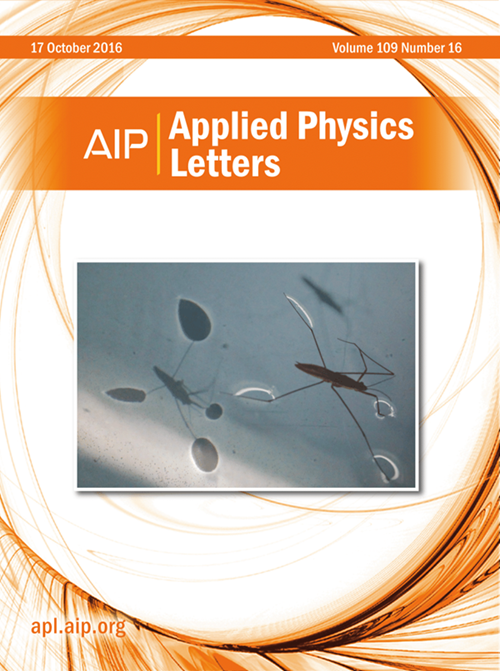结构相变引起的体六方AlN的异常导热系数各向异性
IF 3.5
2区 物理与天体物理
Q2 PHYSICS, APPLIED
引用次数: 0
摘要
六方氮化铝(h-AlN)是一种具有优异导热性的超宽带隙半导体,在电力电子和光电子领域具有广阔的应用前景。先前的研究表明,AlN在压力作用下由纤锌矿结构(wz-AlN)转变为六方氧化镁结构(h-MgO)。然而,对这两种六方相的热输运性质尚未有透彻的认识。在此,我们将第一性原理计算与声子玻尔兹曼输运理论相结合来研究这个问题。考虑四声子散射和声子重整化,我们预测wz-AlN在室温下的面内和面外导热系数(κ)分别为291和268 W/mK,与实验结果吻合较好。相比之下,h-MgO相表现出明显较低的导热系数,面内值为50 W/mK,面外值为93 W/mK。通过对模态声子输运和化学键的进一步分析,我们将h-MgO-AlN的低κ归因于弱Al-N键导致的强非调和性。更重要的是,我们发现h-MgO相表现出不寻常的κ各向异性,面外κ几乎是面内值的两倍,与纤锌矿晶体中观察到的常见行为形成鲜明对比。这种异常是由相变引起的层间键合强化引起的。这项工作为六方体AlN在结构相变过程中的热输运行为提供了一个基本的认识。本文章由计算机程序翻译,如有差异,请以英文原文为准。
Anomalous thermal conductivity anisotropy in bulk hexagonal AlN induced by structural phase transition
Hexagonal aluminum nitride (h-AlN), an ultrawide bandgap semiconductor with exceptional thermal conductivity, holds great promise for applications in power electronics and optoelectronics. Prior studies have shown that AlN undergoes a transition from the wurtzite structure (wz-AlN) to hexagonal magnesium oxide (h-MgO) structure under pressure. However, a thorough understanding of the thermal transport properties of these two hexagonal phases has yet to be established. Herein, we look into this issue by combining the first-principles calculations with phonon Boltzmann transport theory. With the inclusion of four-phonon scattering and phonon renormalization, we predict that the thermal conductivity (κ) of wz-AlN is 291 and 268 W/mK for the in-plane and out-of-plane directions at room temperature, respectively, showing good agreement with experimental measurements. In contrast, the h-MgO phase exhibits a significantly lower thermal conductivity, with the in-plane value of 50 W/mK and the out-of-plane value of 93 W/mK. Through further analysis of modal phonon transport and chemical bonding, we attribute the lower κ of h-MgO-AlN to its stronger anharmonicity resulting from the weaker Al–N bonding. More importantly, we uncover that the h-MgO phase exhibits unusual κ anisotropy with the out-of-plane κ being almost twice as high as the in-plane value, in stark contrast to the common behavior observed in wurtzite crystals. This anomaly is found to arise from the phase transition-induced strengthening of interlayer bonding. This work provides a fundamental understanding of the thermal transport behavior of hexagonal bulk AlN during the structural phase transition.
求助全文
通过发布文献求助,成功后即可免费获取论文全文。
去求助
来源期刊

Applied Physics Letters
物理-物理:应用
CiteScore
6.40
自引率
10.00%
发文量
1821
审稿时长
1.6 months
期刊介绍:
Applied Physics Letters (APL) features concise, up-to-date reports on significant new findings in applied physics. Emphasizing rapid dissemination of key data and new physical insights, APL offers prompt publication of new experimental and theoretical papers reporting applications of physics phenomena to all branches of science, engineering, and modern technology.
In addition to regular articles, the journal also publishes invited Fast Track, Perspectives, and in-depth Editorials which report on cutting-edge areas in applied physics.
APL Perspectives are forward-looking invited letters which highlight recent developments or discoveries. Emphasis is placed on very recent developments, potentially disruptive technologies, open questions and possible solutions. They also include a mini-roadmap detailing where the community should direct efforts in order for the phenomena to be viable for application and the challenges associated with meeting that performance threshold. Perspectives are characterized by personal viewpoints and opinions of recognized experts in the field.
Fast Track articles are invited original research articles that report results that are particularly novel and important or provide a significant advancement in an emerging field. Because of the urgency and scientific importance of the work, the peer review process is accelerated. If, during the review process, it becomes apparent that the paper does not meet the Fast Track criterion, it is returned to a normal track.
 求助内容:
求助内容: 应助结果提醒方式:
应助结果提醒方式:


